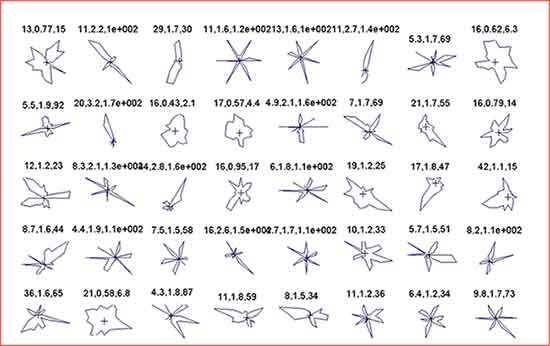SID probes
Aircraft-borne instruments for classifying atmospheric cloud particles
The Small Ice Detector probes are a family of wing-mounted spatial light-scattering instruments that are designed to capture in-situ data relating to the sizes, shapes, and abundance of individual cloud particles such as droplets, ice crystals, aerosol particles, etc. Such information is essential to meteorologists attempting to understand, model, and predict weather patterns and ultimately climate behaviour.
SID1 probes
SID probes designed and built by CACP researchers at the University of Hertfordshire are regularly deployed in research campaigns in the UK, USA, Europe and Australasia.
The image above shows the FAAM (Facility for Airborne Atmospheric Measurements) research aircraft operated by the UK Met Office and university community showing a SID1 probe (black nose) mounted on the port wing.
The original SID1 probe was the world's first aircraft-wing mounted instrument capable of in-situ discrimination between super-cooled cloud droplets and ice crystals down to ~1um size.
SID1 pioneered high-speed multi-angle spatial laser light-scattering techniques to acquire particle shape and size data from individual particles at ~10,000particles/s.
All SID probes work by measuring the scattering patterns produced by individual micrometre-sized particles as they pass through a laser beam at right-angles to the aircraft flight trajectory.
The SID1 probe had just 6 discrete detectors to record this pattern and therefore could make only crude assessments of particle shapes.

SID2 probes
The SID2 probe had 32 detectors arranged radially about the axis of the laser beam. Each measured particle is represented on a polar scattering plot which in turn may be related to the particle's size and shape as the image shows.
SID3 probes
The SID3 probe uses an intensified imaging camera that can record particle scattering patterns at very high resolution (approx. 560x560 pixels).
This allows far more information about the shape and structure of the particle to be determined; for example, the roughness of the surface of ice crystals can be assessed and this roughness can affect the way the crystal interacts with incoming sunlight.
Multiplied over billions of particles, crystal surface roughness can actually affect the warming of the atmosphere.
Example screen dump from the SID3 instrument showing the type of single particle spatial light scattering patterns that the SID3 records
SID example publications
- The effective density of small ice particles obtained from in-situ aircraft observations of mid-latitude cirrus R. J. Cotton, et al. Quarterly Journal of the Royal Meteorological Society (2012), 139: 1923-1934.
- The ability of the Small Ice Detector (SID-2) to characterize cloud particle and aerosol morphologies obtained during flights of the FAAM BAe-146 research aircraft, R. Cotton, S. Osborne, Z. Ulanowski, E. Hirst, P. H. Kaye, and R. S. Greenaway Journal of Atmospheric and Oceanic Technology (2010) 27, Issue 2 (February), 290–303 DOI: 10.1175/2009JTECHA1282.1.
- Simultaneous radar and aircraft observations of mixed-phase cloud at the 100 m scale. Field, P.R., Hogan R. J., Brown P.R.A., Illingworth A.J., Choularton T.W., Kaye P.H., Hirst E., and Greenaway R.S. Quarterly Journal of the Royal Meteorological Society (2004) 130: 1877-1904.
- Ice nucleation in orographic wave clouds: Measurements made during INTACC. Field P R, Cotton R J, Noone K, Glantz P, Kaye P H, Hirst E, Greenaway R G., et al. Quarterly Journal of the Royal Meteorological Society (2001) 127, 575, 1493-1512. (PDF 2578 K)
- Discrimination of micrometre-sized ice and super-cooled droplets in mixed-phase cloud. Hirst E., Kaye P H., Greenaway R S., Field P., and Johnson D W. Atmospheric Environment (2001) 35, 1, 33-47.
SID research timeline
| 1995 | UH is approached by the Met Office to enquire about exploiting our spatial light-scattering technologies in cloud particle measurements. |
|---|---|
| 1996 | A joint NERC (Natural Environment Research Council)-Met Office research project is awarded to develop the first Small Ice Detector probe, SID1. SID1 was subsequently used in more than 50 field campaigns worldwide before its retirement in 2010. |
| 2001 | NERC grant awarded to develop the SID2 aircraft probe. |
| 2005 | NERC grant awarded to develop the SID3 aircraft probe. |
| 2006 | Research contract awarded from NCAR (US National Center for Atmospheric Research) to develop a variant of the SID2 probe for NCAR's HIAPER research aircraft. |
| 2007 | Research contract awarded from Germany's Institute for Meteorology and Climate Research, Karlsruhe, to design and build a variant of SID3 for their AIDA cloud simulation chamber and HALO research aircraft. |
| 2007 | SID2 awarded 'Technology Highlight of 2007' by NERC. |
| 2008 | Research contract awarded from the Leibniz Institute for Tropospheric Research (IfT), Leipzig, Germany, to build a laboratory-based version of SID3 for IfT's LACIS cloud simulation chamber. |
| 2010 | Research contract awarded from the US NCAR to upgrade their SID2 with advanced electronic processing and improved optical performance. |